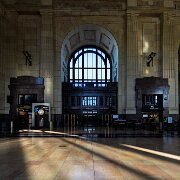
1 Union Station in Kansas City, Missouri, opened in 1914 as a grand symbol of the city’s growth and the golden age of rail travel. Designed by architect Jarvis Hunt in the Beaux-Arts style, the massive 850,000-square-foot building features monumental stone façades, soaring arched windows, and a 95-foot-high Grand Hall with ornate plasterwork and chandeliers. Built to replace the city’s older depot, it incorporated innovative design for efficient passenger flow, with separate levels for arrivals and departures and amenities such as restaurants, shops, and a post office. After years of decline following the reduction of passenger rail service, Union Station was restored in the late 1990s and reopened in 1999 as a thriving cultural and civic landmark, blending historic grandeur with modern attractions.
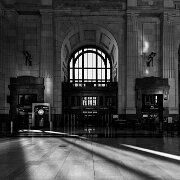
2 Union Station in Kansas City, Missouri, opened in 1914 as a grand symbol of the city’s growth and the golden age of rail travel. Designed by architect Jarvis Hunt in the Beaux-Arts style, the massive 850,000-square-foot building features monumental stone façades, soaring arched windows, and a 95-foot-high Grand Hall with ornate plasterwork and chandeliers. Built to replace the city’s older depot, it incorporated innovative design for efficient passenger flow, with separate levels for arrivals and departures and amenities such as restaurants, shops, and a post office. After years of decline following the reduction of passenger rail service, Union Station was restored in the late 1990s and reopened in 1999 as a thriving cultural and civic landmark, blending historic grandeur with modern attractions.

3 Union Station in Kansas City, Missouri, opened in 1914 as a grand symbol of the city’s growth and the golden age of rail travel. Designed by architect Jarvis Hunt in the Beaux-Arts style, the massive 850,000-square-foot building features monumental stone façades, soaring arched windows, and a 95-foot-high Grand Hall with ornate plasterwork and chandeliers. Built to replace the city’s older depot, it incorporated innovative design for efficient passenger flow, with separate levels for arrivals and departures and amenities such as restaurants, shops, and a post office. After years of decline following the reduction of passenger rail service, Union Station was restored in the late 1990s and reopened in 1999 as a thriving cultural and civic landmark, blending historic grandeur with modern attractions.
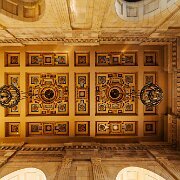
4 Union Station in Kansas City, Missouri, opened in 1914 as a grand symbol of the city’s growth and the golden age of rail travel. Designed by architect Jarvis Hunt in the Beaux-Arts style, the massive 850,000-square-foot building features monumental stone façades, soaring arched windows, and a 95-foot-high Grand Hall with ornate plasterwork and chandeliers. Built to replace the city’s older depot, it incorporated innovative design for efficient passenger flow, with separate levels for arrivals and departures and amenities such as restaurants, shops, and a post office. After years of decline following the reduction of passenger rail service, Union Station was restored in the late 1990s and reopened in 1999 as a thriving cultural and civic landmark, blending historic grandeur with modern attractions.
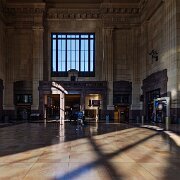
5 Union Station in Kansas City, Missouri, opened in 1914 as a grand symbol of the city’s growth and the golden age of rail travel. Designed by architect Jarvis Hunt in the Beaux-Arts style, the massive 850,000-square-foot building features monumental stone façades, soaring arched windows, and a 95-foot-high Grand Hall with ornate plasterwork and chandeliers. Built to replace the city’s older depot, it incorporated innovative design for efficient passenger flow, with separate levels for arrivals and departures and amenities such as restaurants, shops, and a post office. After years of decline following the reduction of passenger rail service, Union Station was restored in the late 1990s and reopened in 1999 as a thriving cultural and civic landmark, blending historic grandeur with modern attractions.
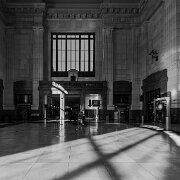
6 Union Station in Kansas City, Missouri, opened in 1914 as a grand symbol of the city’s growth and the golden age of rail travel. Designed by architect Jarvis Hunt in the Beaux-Arts style, the massive 850,000-square-foot building features monumental stone façades, soaring arched windows, and a 95-foot-high Grand Hall with ornate plasterwork and chandeliers. Built to replace the city’s older depot, it incorporated innovative design for efficient passenger flow, with separate levels for arrivals and departures and amenities such as restaurants, shops, and a post office. After years of decline following the reduction of passenger rail service, Union Station was restored in the late 1990s and reopened in 1999 as a thriving cultural and civic landmark, blending historic grandeur with modern attractions.
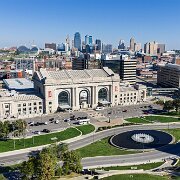
7 Union Station in Kansas City, Missouri, opened in 1914 as a grand symbol of the city’s growth and the golden age of rail travel. Designed by architect Jarvis Hunt in the Beaux-Arts style, the massive 850,000-square-foot building features monumental stone façades, soaring arched windows, and a 95-foot-high Grand Hall with ornate plasterwork and chandeliers. Built to replace the city’s older depot, it incorporated innovative design for efficient passenger flow, with separate levels for arrivals and departures and amenities such as restaurants, shops, and a post office. After years of decline following the reduction of passenger rail service, Union Station was restored in the late 1990s and reopened in 1999 as a thriving cultural and civic landmark, blending historic grandeur with modern attractions.
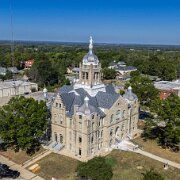
8 The courthouse for Johnson County, Missouri in Warrensburg was constructed between 1896 and 1898 under architect George E. McDonald and stands as a striking example of Romanesque Revival architecture. The building was crafted from locally quarried sandstone and features a robust stone foundation, a prominent central tower topped with a statue of the Roman goddess Minerva, and corner pavilions with turrets and finials. Its design includes round-arched windows and doors, stepped parapets, and grouped stone columns — all hallmarks of the late-19th-century civic-building style in Missouri. Since its first meeting in the completed structure in 1898, the courthouse has served as a longstanding seat of county government and is recognized for both its architectural significance and its role in local civic life.
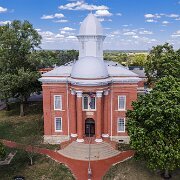
9 The Moniteau County Courthouse in California, Missouri was constructed from 1867 to 1868 on the site of the earlier 1846 brick courthouse, with the Illinois firm Underwood & Conn winning the contract and completing the building in February 1868.
Waymarking
+2
MU Extension
+2
Designed in a Classical-Revival / Neoclassical style, the courthouse features a striking curved portico supporting brick Corinthian columns, a tall white cupola annexe at the roofline and a domed entrance that recalls earlier monumental public buildings.
Flickr
+1
In 1905 significant remodeling under O. E. Sprouce raised the dome by about 20 feet, altered the roof to eliminate leakage, replastered the interior walls and added a decorative metal ceiling to the circuit courtroom—marking its transition into the 20th century.
MU Extension
+1
The courthouse remains in continuous governmental use and serves as the centerpiece of the Moniteau County Courthouse Square historic district, which was listed on the National Register of Historic Places in 1970.
Waymarking
+2
MU Extension
+2
Designed in a Classical-Revival / Neoclassical style, the courthouse features a striking curved portico supporting brick Corinthian columns, a tall white cupola annexe at the roofline and a domed entrance that recalls earlier monumental public buildings.
Flickr
+1
In 1905 significant remodeling under O. E. Sprouce raised the dome by about 20 feet, altered the roof to eliminate leakage, replastered the interior walls and added a decorative metal ceiling to the circuit courtroom—marking its transition into the 20th century.
MU Extension
+1
The courthouse remains in continuous governmental use and serves as the centerpiece of the Moniteau County Courthouse Square historic district, which was listed on the National Register of Historic Places in 1970.
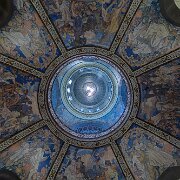
10 The Missouri State Capitol, located in Jefferson City, was completed in 1917 after the previous capitol was destroyed by fire in 1911. Constructed of Carthage marble and built at a cost of about $4 million, the Beaux-Arts style building was designed by the architectural firm Tracy and Swartwout of New York. The grand structure features a massive central dome rising 238 feet above the ground, adorned with a bronze statue of Ceres, the Roman goddess of agriculture. The interior is richly decorated with murals, sculptures, and mosaics celebrating Missouri’s history, culture, and natural beauty, including the renowned murals by Thomas Hart Benton. Overlooking the Missouri River

11 The Missouri State Capitol, located in Jefferson City, was completed in 1917 after the previous capitol was destroyed by fire in 1911. Constructed of Carthage marble and built at a cost of about $4 million, the Beaux-Arts style building was designed by the architectural firm Tracy and Swartwout of New York. The grand structure features a massive central dome rising 238 feet above the ground, adorned with a bronze statue of Ceres, the Roman goddess of agriculture. The interior is richly decorated with murals, sculptures, and mosaics celebrating Missouri’s history, culture, and natural beauty, including the renowned murals by Thomas Hart Benton. Overlooking the Missouri River

12 The Missouri State Capitol, located in Jefferson City, was completed in 1917 after the previous capitol was destroyed by fire in 1911. Constructed of Carthage marble and built at a cost of about $4 million, the Beaux-Arts style building was designed by the architectural firm Tracy and Swartwout of New York. The grand structure features a massive central dome rising 238 feet above the ground, adorned with a bronze statue of Ceres, the Roman goddess of agriculture. The interior is richly decorated with murals, sculptures, and mosaics celebrating Missouri’s history, culture, and natural beauty, including the renowned murals by Thomas Hart Benton. Overlooking the Missouri River
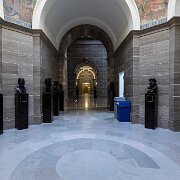
13 The Missouri State Capitol, located in Jefferson City, was completed in 1917 after the previous capitol was destroyed by fire in 1911. Constructed of Carthage marble and built at a cost of about $4 million, the Beaux-Arts style building was designed by the architectural firm Tracy and Swartwout of New York. The grand structure features a massive central dome rising 238 feet above the ground, adorned with a bronze statue of Ceres, the Roman goddess of agriculture. The interior is richly decorated with murals, sculptures, and mosaics celebrating Missouri’s history, culture, and natural beauty, including the renowned murals by Thomas Hart Benton. Overlooking the Missouri River
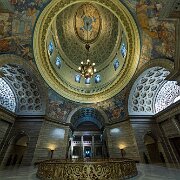
14 The Missouri State Capitol, located in Jefferson City, was completed in 1917 after the previous capitol was destroyed by fire in 1911. Constructed of Carthage marble and built at a cost of about $4 million, the Beaux-Arts style building was designed by the architectural firm Tracy and Swartwout of New York. The grand structure features a massive central dome rising 238 feet above the ground, adorned with a bronze statue of Ceres, the Roman goddess of agriculture. The interior is richly decorated with murals, sculptures, and mosaics celebrating Missouri’s history, culture, and natural beauty, including the renowned murals by Thomas Hart Benton. Overlooking the Missouri River

15 The Missouri State Capitol, located in Jefferson City, was completed in 1917 after the previous capitol was destroyed by fire in 1911. Constructed of Carthage marble and built at a cost of about $4 million, the Beaux-Arts style building was designed by the architectural firm Tracy and Swartwout of New York. The grand structure features a massive central dome rising 238 feet above the ground, adorned with a bronze statue of Ceres, the Roman goddess of agriculture. The interior is richly decorated with murals, sculptures, and mosaics celebrating Missouri’s history, culture, and natural beauty, including the renowned murals by Thomas Hart Benton. Overlooking the Missouri River

16 The Missouri State Capitol, located in Jefferson City, was completed in 1917 after the previous capitol was destroyed by fire in 1911. Constructed of Carthage marble and built at a cost of about $4 million, the Beaux-Arts style building was designed by the architectural firm Tracy and Swartwout of New York. The grand structure features a massive central dome rising 238 feet above the ground, adorned with a bronze statue of Ceres, the Roman goddess of agriculture. The interior is richly decorated with murals, sculptures, and mosaics celebrating Missouri’s history, culture, and natural beauty, including the renowned murals by Thomas Hart Benton. Overlooking the Missouri River
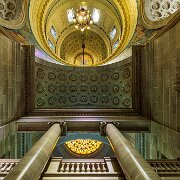
17 The Missouri State Capitol, located in Jefferson City, was completed in 1917 after the previous capitol was destroyed by fire in 1911. Constructed of Carthage marble and built at a cost of about $4 million, the Beaux-Arts style building was designed by the architectural firm Tracy and Swartwout of New York. The grand structure features a massive central dome rising 238 feet above the ground, adorned with a bronze statue of Ceres, the Roman goddess of agriculture. The interior is richly decorated with murals, sculptures, and mosaics celebrating Missouri’s history, culture, and natural beauty, including the renowned murals by Thomas Hart Benton. Overlooking the Missouri River
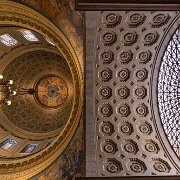
18 The Missouri State Capitol, located in Jefferson City, was completed in 1917 after the previous capitol was destroyed by fire in 1911. Constructed of Carthage marble and built at a cost of about $4 million, the Beaux-Arts style building was designed by the architectural firm Tracy and Swartwout of New York. The grand structure features a massive central dome rising 238 feet above the ground, adorned with a bronze statue of Ceres, the Roman goddess of agriculture. The interior is richly decorated with murals, sculptures, and mosaics celebrating Missouri’s history, culture, and natural beauty, including the renowned murals by Thomas Hart Benton. Overlooking the Missouri River
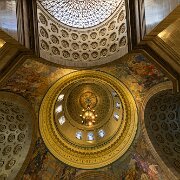
19 The Missouri State Capitol, located in Jefferson City, was completed in 1917 after the previous capitol was destroyed by fire in 1911. Constructed of Carthage marble and built at a cost of about $4 million, the Beaux-Arts style building was designed by the architectural firm Tracy and Swartwout of New York. The grand structure features a massive central dome rising 238 feet above the ground, adorned with a bronze statue of Ceres, the Roman goddess of agriculture. The interior is richly decorated with murals, sculptures, and mosaics celebrating Missouri’s history, culture, and natural beauty, including the renowned murals by Thomas Hart Benton. Overlooking the Missouri River
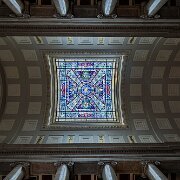
20 The Missouri State Capitol, located in Jefferson City, was completed in 1917 after the previous capitol was destroyed by fire in 1911. Constructed of Carthage marble and built at a cost of about $4 million, the Beaux-Arts style building was designed by the architectural firm Tracy and Swartwout of New York. The grand structure features a massive central dome rising 238 feet above the ground, adorned with a bronze statue of Ceres, the Roman goddess of agriculture. The interior is richly decorated with murals, sculptures, and mosaics celebrating Missouri’s history, culture, and natural beauty, including the renowned murals by Thomas Hart Benton. Overlooking the Missouri River
Missouri